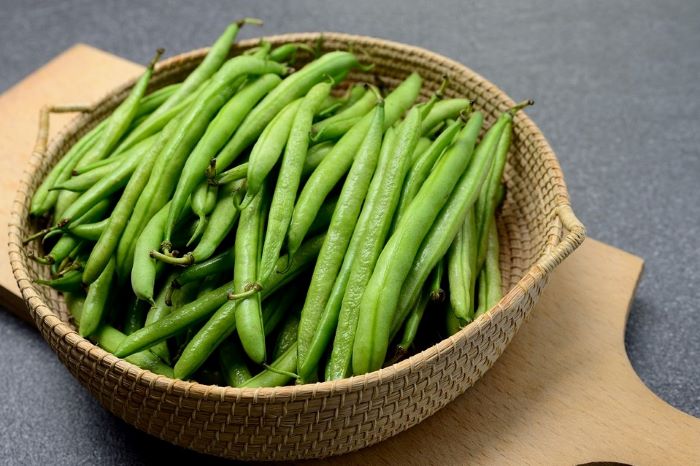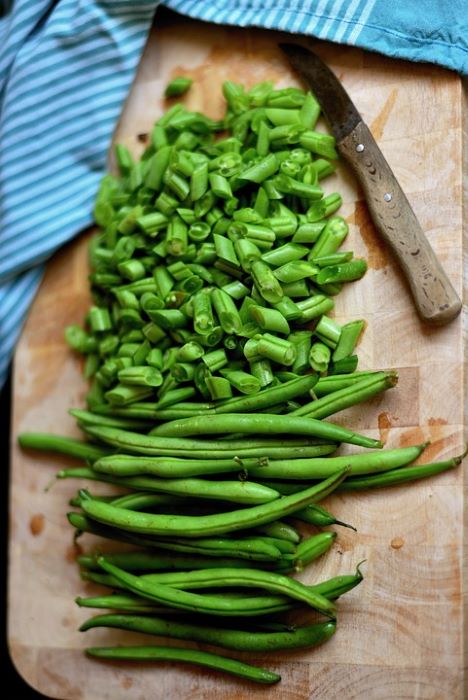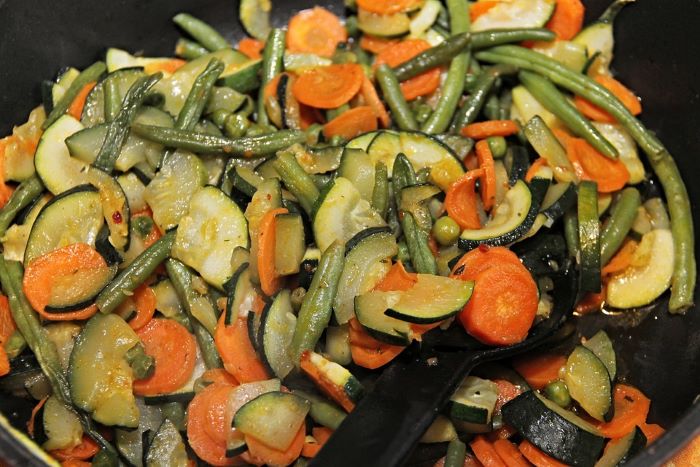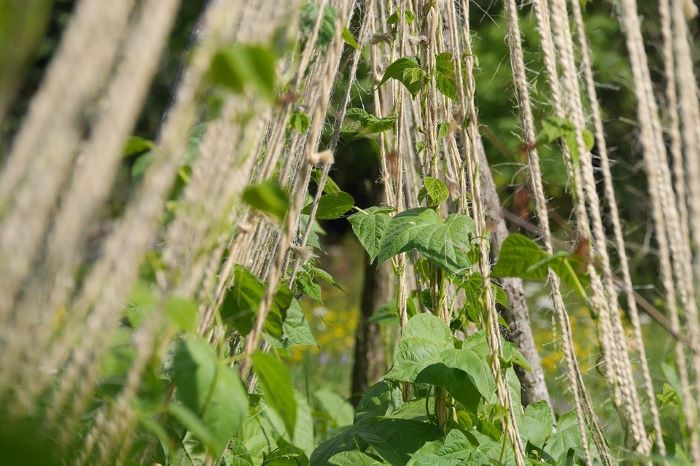Green beans are easy to grow and easy to cook. But, whether you bought them from the grocery store or harvested them from your garden, it is equally disappointing when you sit down to eat your green beans, and they are unpleasantly bitter. Let’s look at why your green beans are bitter and how to make them taste better.

Table of Contents
Why Are My Green Beans Bitter?
The reason green beans taste bitter is due to an excess of bitter producing compounds such as tannins, lectins, and saponins. While these compounds are naturally produced during the growing period, a surplus will produce an overly bitter green bean.
This occurs when the green bean plant (also known as common bean) is under stress or when the growing conditions are not ideal.
Late harvesting also results in bitter green beans. Additionally, the time between harvest and eating can also affect the taste of green beans which become more bitter with age.
Green beans taste a lot better when they are eaten soon after being harvested and they are not overcooked.
Are Bitter Green Beans Safe to Eat?
Yes, bitter green beans are perfectly safe to eat. Though due to their bitter flavor, you might not be too keen to eat many of them without taking steps to mask the bitterness. More on this below.
Picking the Best Green Beans in the Supermarket
Even though bitter green beans are safe to eat, it would be better to have sweet ones. So how do you identify the best green beans in a supermarket?
First look at the color of the beans. As they age, they might start to go brown.
Yellow can also be an indication of age or poor growing conditions. Keep in mind that there are some varieties of green beans that are not green. Don’t confuse these purple or yellow beans as bad quality beans.
If possible, check for moisture in the packet and the beans themselves. You can do this by snapping them. If they seem dry or the tips appear withered they may be older.
Similarly, if the water in the packet is discolored it may have been sitting for longer.
It’s always better to choose the refrigerated green beans over those in the produce section if you don’t want bitterness. Most of these should have a best-before date on the packaging. I often dig in the back of the refrigerators to find those with the longest expiry date.
Why Green Beans Go Bitter After Cooking
You were so sure that you had great green beans. They were so pleasant they could be eaten raw. So why did they go bitter after you prepared them?
They were overcooked!
Overcooking green beans leads to an increase in saponin levels and therefore bitterness. Some signs of overcooking include green beans that are no longer supple, or that start to turn brown.
In some cases, they may start to disintegrate entirely.
Sometimes, this can also be an issue in certain brands of canned beans.
How to Make Green Beans Taste Better

Balance the Bitter Flavor
If you only realized your green beans were bitter after you had already started cooking them, the best thing you can do is add something to balance the bitter flavor or mask it.
Chili pairs very well with a bitter taste and can often be added using chili flakes or paste when you are almost done cooking.
Citrus may also improve the flavor of your bitter green beans. But, make sure to approach with caution. Some lemons can be very bitter too and may make the situation worse. I sometimes use orange juice (the kind you would drink). A small splash is more than enough.
If you have kids who aren’t keen on spicy or sour food, try some sugar instead. This can either be granulated sugar, if you still have some cooking time you can play with, or it can be something like mayple syrup or honey.
Not sure any of these will work for you? Maybe you need to mask the flavor entirely. A popular southern dish is green beans with bacon bits and maple syrup. All you taste is bacon!
Although it may defeat the purpose of having a healthy vegetable dish, it can be thrown together in a few minutes and is ideal if your green beans were meant for a party.
You can also add your green beans in with other vegetables such as carrots which are sweet, to help disguise the bitter flavor.

Blanch Your Green Beans First
Blanching your green beans is one of the best ways to remove some of the bitter flavors.
Blanch your green beans by bringing water to a boil and then dropping the green beans in. Remove them when they start to turn bright green. This should take no more than two or three minutes.
Then immediately place them in ice-cold water. This stops new enzymes from being released.
Refrigerate Green Beans Immediately
As more time passes after your green beans have been harvested, the chemical compounds that turns them bitter become more concentrated.
The bean plant sees the site where it has been cut or broken while being harvested as damage and therefore reacts by producing bitter compounds!
If you have to harvest a while before cooking and eating, make sure to refrigerate your green beans. The cold stops this enzyme from working as quickly, giving you more time to eat them. However, they will still go bitter eventually.
Stored in the refrigerator, green beans should remain fresh for around 7 days.
Optimal Growing Conditions for Your Green Bean Plants

If you are growing your own green beans and are yet to harvest them or have only harvested some, maybe try to address the growing conditions of your green bean plant. This will decrease the amount of bitter compounds being produced.
Remember, if anything is not ideal, there may be some cell death creating a bitter taste. Consider the following.
1. Water: If the leaves of your green bean plant look dry, it probably isn’t getting enough water. If they start turning yellow but remain supple for a few days before dying, it may mean that there is too much water. Green beans should be watered roughly twice a week.
2. High Temperature: If your climate is too warm for green beans you may start noticing brown ‘burns’ on your plant. If this is the case consider moving them to an area that only gets early morning sun or using some shadecloth to sheild them from the strong sun.
3. Soil: Minerals can be leached from the soil if there are too many plants too close together. This can also happen if you plant in the same soil for many years. The pH of your soil is important too and may vary depending on the green bean variety.
4. Cold damage: Just like frostbite in humans, cold damage can cause cell death in plants. Some varieties are more cold-tolerant than others so do your research before planting.
5. Late harvesting: Green beans are best harvested when they are 4-7 inches long (10-17 cm) depending on the variety. If the beans are left of the plant for too long, they can become bitter.
Related: Bean Plants Dying? 7 Causes and Solutions
Least Bitter Green Bean Varieties
The best green bean varieties differ depending on your growing conditions. More cold-tolerant green beans produce less Saponins due to cold damage, and so on.
Here are a couple that you may want to consider. Keep in mind, the best green bean available to you may not be green!
For a crisp, sweet green bean consider the Blue Lake Bush variety.
If you are in an area that experiences particularly warm summers, something like the Tendergreen green bean will be better.
Porch Pick is a variety that is ideal in pots, which can be moved inside if you expect heavy frosts.
But, if you would like to keep your green beans outside and have a particularly short growing season then the Strike variety green beans grow very quickly.
Regardless of which variety you have at the moment though, with proper care and a little bit of experience, you should be able to produce sweet green beans if you do your research and consider what might be stressing your plant.
Related Reading:
